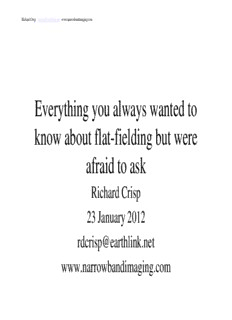
Everything you always wanted to know about flat-fielding but were afraid to ask PDF
Preview Everything you always wanted to know about flat-fielding but were afraid to ask
Richard Crisp [email protected] www.narrowbandimaging.com Everything you always wanted to know about flat-fielding but were afraid to ask Richard Crisp 23 January 2012 [email protected] www.narrowbandimaging.com Richard Crisp [email protected] www.narrowbandimaging.com Outline • Purpose • Part 1: Noise • Part 2: Photon Transfer Analysis: basic concepts (tools we’ll use) • Part 3: Flat Fielding Basic Concepts: what it does, how it works, performance measurement • Part 4: Making Master Flats: what level of signal, how many exposures • Part 5: Field Techniques: taking sky flats, qualifying a master flat prior to deployment Richard Crisp [email protected] www.narrowbandimaging.com Purpose • The purpose of this material is to teach – What flat fielding does – How it works – How to quantify results – Introduction and use of basic camera analysis tools/techniques – How to design an optimized flat fielding protocol for your camera Richard Crisp [email protected] www.narrowbandimaging.com Part 1: Noise • Image noise sources • Noise Equation • Graphical Representation Richard Crisp [email protected] www.narrowbandimaging.com Image Noise Sources • For an unmodulated image (flat field image), the key noise sources* are – Read noise – Signal Shot Noise – Fixed Pattern Noise • Depending on signal level any of them can dominate the noise in a single image frame *neglecting dark signal noise sources which can be managed by cooling Richard Crisp [email protected] www.narrowbandimaging.com Read Noise • The read noise is the noise observed in an image when no signal is present • The noise in a bias frame approximates the read noise – zero length exposure – no light applied – bias frame noise differs from read noise floor by dark signal accumulation during finite readout time • Read noise can obliterate faint signals Richard Crisp [email protected] www.narrowbandimaging.com Shot Noise • The discrete nature of photons results in a variation of the intensity of the incident light as viewed on a photon by photon basis as a function of time • The variation is the cause of photon shot noise or shot noise as it is also known • The more intense the image, the greater is the shot noise • Shot noise is inherent in the image and cannot be avoided and represents the noise floor • Shot noise in a final image can be eliminated by combining multiple images Richard Crisp [email protected] www.narrowbandimaging.com Fixed Pattern Noise • For a flat field exposure, any modulation observed that remains constant from frame is Fixed Pattern Noise (FPN) • For perfect flat-field illumination of the sensor the FPN observed is caused by variations in the photoresponse of each pixel. This represents the floor of the FPN of the system • For the camera installed on a practical optical imaging system, variations of light intensity are generally observed – Non-uniform light intensity across the frame (ie, “hot centers”) – Dust motes – Filter transmission variations • These Optical FPN components add to the FPN inherent in the sensor and frequently dominate the overall FPN of the system • Once FPN dominates the noise of the image, collecting additional signal does not improve the Signal to Noise Ratio (SNR). FPN places an upper limit on the SNR of the system unless removed • FPN is removed via Flat Fielding (explained later) Richard Crisp [email protected] www.narrowbandimaging.com Examples of Fixed Pattern Noise Sensor FPN Optical FPN Richard Crisp [email protected] www.narrowbandimaging.com Flat Fielding for FPN Removal Sensor FPN removal Optical FPN removal
Description: